Brewing Beer with Golden Promise Malt
Published: August 13, 2025 at 7:55:45 AM UTC
Last updated: December 12, 2025 at 3:13:08 PM UTC
Golden Promise malt is a favorite among brewers for its distinct taste and sweeter profile. It's akin to Maris Otter but with a unique twist. Hailing from Scotland, this malt has been a cornerstone in brewing for decades. Using Golden Promise malt allows brewers to craft a variety of beers with a richer, sweeter taste. Its sweeter flavor is a draw for those aiming to set their beers apart from others made with different malts.
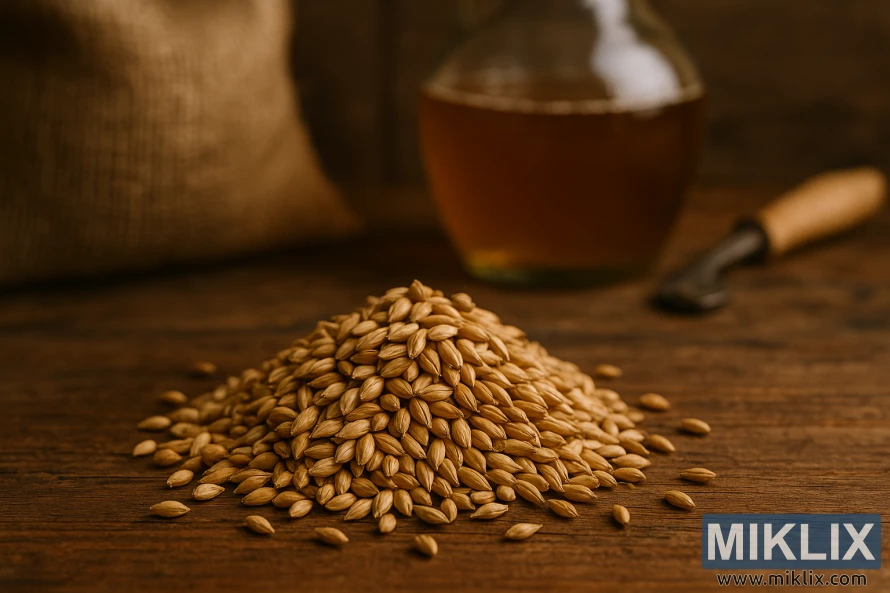
Key Takeaways
- Golden Promise malt has a sweeter flavor profile compared to Maris Otter.
- It is a popular choice for brewing a variety of beer styles.
- The malt's origin is Scotland, where it has been used for decades.
- Brewing with Golden Promise can result in beers with richer characters.
- It offers brewers a unique alternative to traditional malts.
Understanding Golden Promise Malt
Golden Promise malt has its roots in Scottish agriculture, bred for the distilling industry. This background has shaped its distinct traits, making it essential in traditional Scottish brewing.
The creation of Golden Promise malt was a response to the agricultural and industrial demands of its time. It was designed to be high-yielding and strong, qualities that distillers highly prized. Brewers later recognized its unique attributes, adding to the flavor and quality of beer.
Some key aspects of Golden Promise malt include:
- High-quality barley variety
- Originally developed for the distilling industry
- Adopted by brewers for its unique flavor profile
- Significant in traditional Scottish beer styles
The use of Golden Promise malt in brewing was driven by its availability and quality. Its slightly sweeter taste, compared to malts like Maris Otter, made it appealing for brewers aiming to craft distinct beers.
Key benefits of using Golden Promise malt include:
- Enhanced flavor complexity
- Improved beer quality
- Tradition and heritage in Scottish brewing
Exploring the history and development of Golden Promise malt reveals its importance in brewing. Its unique qualities and the tradition surrounding its use make it a key ingredient in creating high-quality beers.
The Historical Significance of Golden Promise in Scottish Brewing
Golden Promise malt has been a cornerstone in Scottish brewing, influencing the country's beer styles profoundly. Its role is rooted in its ability to craft high-quality, flavorful beers. These beers are now emblematic of Scottish brewing traditions.
For decades, Golden Promise has been a mainstay in Scottish breweries, featured in various traditional beer styles. Its slightly sweeter profile, compared to malts like Maris Otter, makes it a top choice for brewers. They seek to create beers with a unique taste.
The impact of Golden Promise on Scottish brewing is immense, enriching the country's brewing heritage. It's key in making traditional Scottish ales and lagers, adding a distinct flavor and aroma. This is cherished by Scottish beer lovers.
- Enhances the flavor profile of traditional Scottish beers
- Contributes to the rich brewing heritage of Scotland
- Preferred for its slightly sweeter character
The historical importance of Golden Promise in Scottish brewing highlights its quality and versatility. As Scottish breweries grow and change, Golden Promise's legacy remains a vital part of their traditions.
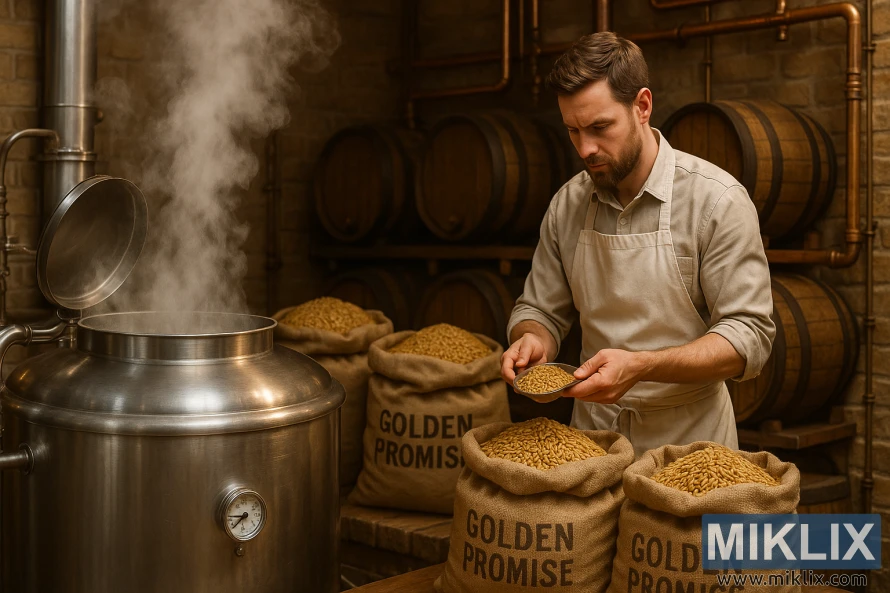
Chemical Composition and Malt Specifications
Golden Promise malt is celebrated for its unique chemical makeup, which greatly impacts brewing. Its diastatic power, a key indicator of starch conversion into fermentable sugars, is essential for brewhouse efficiency.
The malt's specifications include a diastatic power of 120-140 °L, highlighting its strong enzymatic prowess. Its moisture content is kept under 5%, ensuring the malt's stability and longevity.
Chemically, Golden Promise malt boasts a protein content of 9-11%. This moderate protein level aids in creating a balanced beer with stable foam and a smooth mouthfeel.
Its high extract content makes Golden Promise an efficient malt for brewers. The fine grind extract (FGE) and coarse grind extract (CGE) values are critical for recipe formulation and optimizing the brewing process.
- Diastatic Power: 120-140 °L
- Moisture Content: <5%
- Protein Content: 9-11%
- Extract Content: High FGE and CGE values
Grasping these malt specifications is essential for brewers. It allows them to fine-tune their recipes and brewing methods to achieve the perfect beer.
Golden Promise vs Maris Otter: A Detailed Comparison
Golden Promise and Maris Otter are both celebrated malts in the brewing world. Yet, they differ significantly. These malts are chosen for various beer styles and brewing methods, each with unique characteristics.
Golden Promise stands out for its sweeter and more pronounced flavor. It's a two-row spring barley malt, a favorite in Scottish brewing for decades. Its rich, malty taste is perfect for traditional Scottish ales and lagers.
Maris Otter, in contrast, is known for its rich, complex flavor. It's often described as having a more refined character than Golden Promise. This two-row barley malt has a slightly drier and more nuanced taste. It's a top pick for brewers aiming to create high-quality pale ales and other styles where a subtle malt flavor is key.
Brewers should consider their beer's specific needs when choosing between Golden Promise and Maris Otter. Golden Promise is ideal for those seeking a robust, malty flavor. Maris Otter, on the other hand, is better for those aiming for a more subtle malt character.
- Golden Promise: Sweeter, more pronounced flavor; ideal for traditional Scottish ales and lagers.
- Maris Otter: Rich, complex, slightly drier; suitable for pale ales and beers requiring a subtle malt flavor.
In conclusion, while both Golden Promise and Maris Otter are of high quality, their distinct flavors and brewing characteristics cater to different needs. Understanding these differences helps brewers make the right choice for their recipes.
Flavor Profile and Aromatic Properties
Golden Promise malt is celebrated for its unique flavor and aroma, greatly enriching beer's character. Brewers often highlight its rich, malty taste with hints of sweetness. This makes it a favorite for those aiming to craft complex beers.
The malt's aromatic properties are equally noteworthy, bringing a deep, malty scent to the brew. This quality is highly valued for its ability to add depth and character to various beer styles.
Compared to malts like Maris Otter, Golden Promise is noted for its slightly sweeter character. This sweetness is balanced by a subtle complexity, elevating the beer's overall flavor.
Golden Promise malt is ideal for brewers seeking to create beers with a rich, malty taste and aroma. Its unique flavor and aroma are versatile, fitting a range of beer styles from traditional Scottish ales to modern craft brews.
- Rich, malty flavor
- Subtle notes of sweetness
- Deep, malty aroma
- Complexity and depth in beer
Best Beer Styles for Golden Promise Malt
Golden Promise malt stands out for its unique traits, making it perfect for various beer styles. Its slightly sweeter taste and rich flavor profile are ideal for brewers aiming to craft complex beers. This malt's characteristics offer a solid foundation for creating nuanced brews.
It's a top pick for traditional Scottish ales, where its malty sweetness can truly shine. Golden Promise malt is also favored for brewing IPAs and other hop-forward beers. Its rich malt flavor provides a balanced backdrop for the hoppy notes.
- Scottish Ale: A classic style that showcases the malt's rich, malty flavor.
- IPA: The malt's sweetness balances the hoppiness in this popular style.
- Amber Ale: Golden Promise adds depth and complexity to this malty, caramel-flavored style.
- Barley Wine: The malt's rich flavor profile makes it an excellent choice for strong, complex barley wines.
Brewers can anticipate a rich, full-bodied flavor with a hint of sweetness when using Golden Promise malt. By leveraging its unique characteristics, brewers can craft a wide array of delicious and complex beers. This malt's versatility is a boon for those looking to experiment with different beer styles.
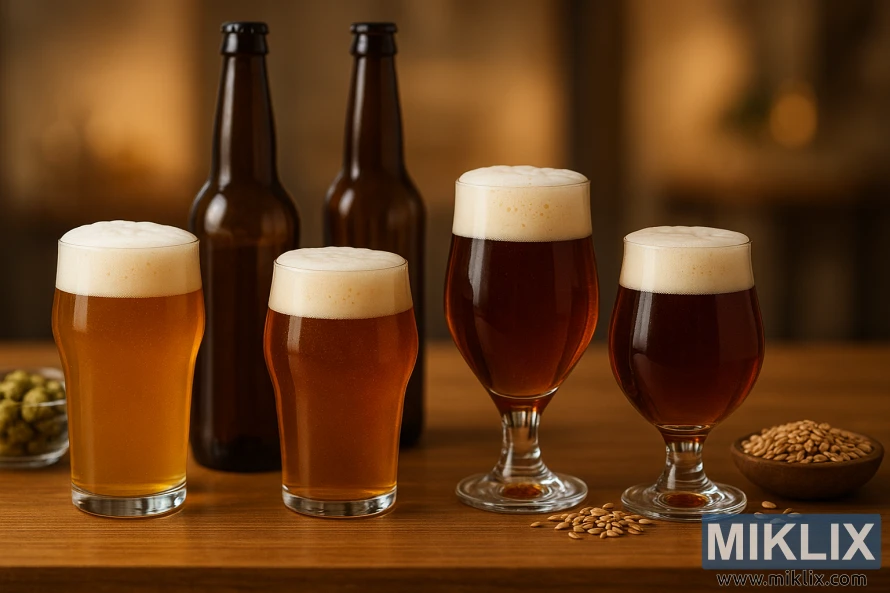
Mashing Techniques for Optimal Extract
Unlocking the full flavor of Golden Promise malt requires a deep dive into mashing techniques. Mashing is a critical step in brewing, impacting both the quality and quantity of the extract. Golden Promise, with its slightly sweeter profile, demands precise mashing conditions to reach its peak.
The temperature during mashing is a key factor. Most brewers find a temperature range of 152°F to 155°F (66°C to 68°C) ideal for a balanced extract. Yet, the optimal temperature can vary based on the beer style being brewed.
Water chemistry is another essential aspect of mashing. The mash pH should be between 5.2 and 5.4 for optimal enzyme activity. Brewers can tweak the pH by using different water types or adding salts to the brewing water.
The grain-to-water ratio is also critical. A standard ratio is about 1:2.5 (grain:water), but adjustments can be made based on mash consistency and brewing equipment needs.
Optimizing the mashing process involves considering the malt type. Golden Promise, being high-quality, benefits from a well-designed mashing regimen. Key considerations include:
- Using a step mash or infusion mash to control temperature and extract quality.
- Monitoring the mash pH and adjusting as needed.
- Avoiding over-sparging to prevent a decrease in extract quality.
By mastering these mashing techniques, brewers can enhance the extract from Golden Promise malt, leading to a superior beer. Whether crafting a traditional Scottish ale or a modern craft beer, the right mashing techniques are essential.
Recipe Formulation Guidelines
Brewing with Golden Promise requires finding the right balance between its sweeter malt and the perfect hops. This balance is essential for achieving the best flavor and aroma in the beer.
Begin by deciding on the beer style you aim to brew. Golden Promise malt is versatile, suitable for both traditional Scottish ales and modern IPAs.
- Begin with a base malt percentage of 70-80% Golden Promise to highlight its character.
- Choose specialty malts that complement its sweetness, like caramel or Munich malts.
- Select hops that balance its sweetness, such as East Kent Goldings or Cascade hops.
- Experiment with different yeast strains to enhance the beer's flavor and aroma.
Here are some successful Golden Promise recipes:
- A Scottish Ale with 75% Golden Promise, 20% caramel malt, and 5% chocolate malt, hopped with East Kent Goldings.
- An IPA with 80% Golden Promise, 10% wheat malt, and 10% Munich malt, hopped with Cascade and Chinook hops.
- A Pale Ale with 70% Golden Promise, 15% crystal malt, and 15% Pilsner malt, hopped with Willamette and Simcoe hops.
By adhering to these guidelines and experimenting, brewers can fully exploit Golden Promise malt. This leads to a wide variety of tasty beers.
Common Brewing Challenges and Solutions
Golden Promise malt, known for its distinct characteristics, can present brewers with unique challenges that require tailored solutions. Achieving the optimal mash consistency is a primary concern. This consistency significantly impacts the overall quality of the beer.
Brewing with Golden Promise malt can lead to issues such as inconsistent flavor profiles and difficulties in achieving the desired beer characteristics. To address these challenges, brewers must carefully consider their mashing techniques and recipe formulations.
To overcome the challenges associated with Golden Promise malt, brewers can employ several strategies. These include adjusting mashing temperatures and techniques, optimizing grain bills, and ensuring proper storage and handling of the malt to preserve its quality.
- Adjust mashing temperatures to optimize enzyme activity and achieve the desired fermentable sugar profile.
- Modify grain bills to balance the flavor and color contributions of Golden Promise malt.
- Implement proper storage and handling practices to maintain the quality and consistency of Golden Promise malt.
By understanding the common brewing challenges associated with Golden Promise malt and implementing effective solutions, brewers can unlock the full versatility of this ingredient. They can produce high-quality beers that showcase its unique characteristics.
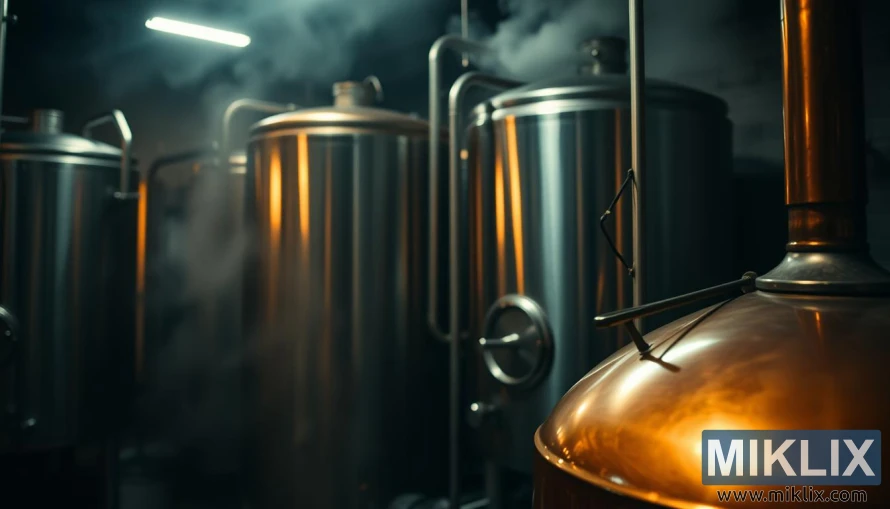
Commercial Breweries Using Golden Promise
Commercial breweries globally are embracing Golden Promise malt for its unique flavor and versatility. This malted barley variety has become a favorite among brewers for its rich taste and adaptability in brewing.
Several renowned breweries have successfully integrated Golden Promise into their recipes. For example, Scottish breweries use it to craft traditional ales with a deep, malty flavor. The malt's slightly sweeter taste enhances the overall flavor, making it a top choice for many brewers.
Some notable examples of commercial breweries using Golden Promise malt include:
- Breweries in Scotland that produce traditional ales and heather beers
- Craft breweries in the United States experimenting with Golden Promise in various beer styles
- European breweries incorporating Golden Promise into their lagers and ales
These breweries value Golden Promise for its consistent quality and the depth of flavor it adds to their beers. By understanding how commercial breweries use Golden Promise, brewers can explore its full range of applications and benefits.
Storage and Handling Requirements
To ensure the optimal performance of Golden Promise malt, brewers must adhere to specific storage and handling guidelines. Proper care is essential to maintain the quality and freshness of the malt.
Golden Promise malt should be stored in a cool, dry environment, away from direct sunlight and moisture. The ideal storage conditions include a consistent refrigerated temperature below 40°F (4°C) or a cool, dry area with low humidity if refrigeration is not available.
When handling Golden Promise malt, brewers should minimize exposure to air to prevent oxidation and the absorption of unwanted flavors or aromas. It's also important to keep the malt away from strong-smelling substances, as it can absorb odors easily.
Best practices for inventory management include:
- First-in, first-out inventory system to ensure older stock is used before it degrades.
- Regularly inspecting malt for signs of spoilage or deterioration.
- Storing malt in airtight containers or bags that are designed for malt storage.
By following these guidelines, brewers can ensure that their Golden Promise malt remains in optimal condition. This is ready for use in brewing high-quality beers.
Blending Golden Promise with Other Malts
The art of blending Golden Promise with other malts is a technique worth exploring for brewers. It allows them to craft unique and complex beers. Golden Promise, known for its slightly sweeter character, offers a versatile base for various malt blends.
Blending Golden Promise with other malts enables brewers to fine-tune the flavor profile of their beers. For instance, combining it with chocolate malt can add depth and richness to a stout or porter. On the other hand, blending it with a lighter malt can enhance the beer's overall brightness and dryness.
When blending Golden Promise with other malts, several considerations come into play. The first is the flavor profile desired in the final beer. Brewers must consider how different malts will interact with Golden Promise. For example, pairing Golden Promise with wheat malt can create a refreshing and crisp beer, ideal for summer brews.
- Determine the desired flavor profile for your beer.
- Select malts that complement or contrast with Golden Promise's characteristics.
- Experiment with different ratios of Golden Promise to other malts.
Experimentation is key when blending malts. Brewers are encouraged to try different combinations to discover new and interesting flavors. Keeping detailed records of the blends and their outcomes is essential for refining recipes and achieving consistency.
Some brewers have found success by blending Golden Promise with malts like Munich or Victory. This adds complexity and a hint of toasted flavors to their beers. The possibilities are vast, and the art of blending is limited only by the brewer's imagination and experimentation.
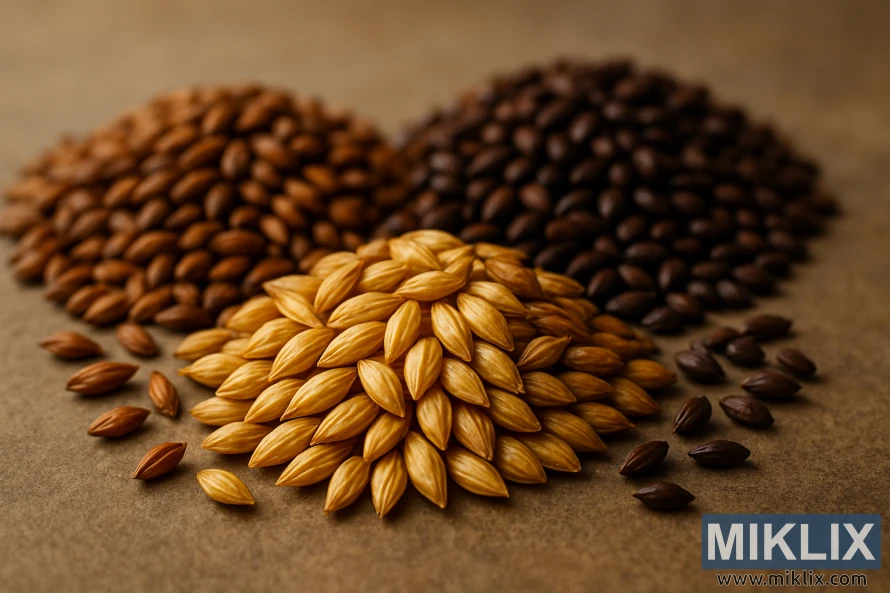
Impact on Final Beer Characteristics
Brewing with Golden Promise malt results in beers with unique flavor profiles and aromatic properties. The distinct characteristics of Golden Promise malt significantly contribute to the overall quality and character of the beer.
The flavor profile of beers brewed with Golden Promise malt is often described as sweeter and richer compared to those brewed with other malts like Maris Otter. This is due to the malt's inherent properties, which include a higher level of diastatic power and a specific chemical composition that enhances the fermentation process.
The aromatic properties of Golden Promise malt are another critical aspect that brewers consider. The malt imparts a complex aroma that includes notes of sweetness, bread, and sometimes a hint of nuttiness. This complex aromatic profile is a result of the malt's kilning process and its inherent chemical makeup.
In terms of appearance, Golden Promise malt can influence the beer's color and clarity. Beers brewed with this malt tend to have a rich, golden color, which is where the malt gets its name. The clarity of the beer can also be affected, depending on the brewing techniques and other ingredients used.
Here are some key characteristics that Golden Promise malt imparts to the final beer:
- Rich, sweeter flavor profile
- Complex aromatic properties
- Rich, golden color
- Potential for improved clarity when used with appropriate brewing techniques
Overall, Golden Promise malt is a versatile ingredient that can be used in a variety of beer styles, from traditional Scottish ales to more modern craft beers. Its unique properties make it an attractive choice for brewers looking to create beers with distinct flavor profiles and aromatic characteristics.
Cost Considerations and Availability
The cost of Golden Promise malt is a critical factor for brewers to consider when planning their recipes. As a premium malt, Golden Promise is priced higher. This can significantly impact the overall production costs of breweries.
When it comes to sourcing Golden Promise malt, brewers have a few options. They can purchase directly from malt suppliers or distributors. The availability of Golden Promise malt can vary depending on the supplier and the time of year. It's essential for brewers to plan ahead and ensure a steady supply of this critical ingredient.
Here are some key considerations for brewers when evaluating the cost and availability of Golden Promise malt:
- Pricing: Golden Promise malt is generally priced higher than other malts due to its high-quality characteristics.
- Sourcing: Brewers should research and establish relationships with reliable malt suppliers to ensure a consistent supply.
- Supply chain: Understanding the supply chain and possible lead times is key for brewers to plan their production schedules effectively.
By considering these factors, brewers can better manage their costs and ensure a steady supply of Golden Promise malt. This, in turn, enables them to produce high-quality beers that meet their customers' expectations.
Sustainability and Environmental Impact
Brewers are increasingly focusing on sustainable practices, leading to a closer look at the environmental impact of ingredients like Golden Promise malt. The cultivation of Golden Promise barley involves agricultural practices that can have both positive and negative effects on the environment.
On the positive side, Golden Promise is known for its robust growth characteristics. This can lead to more efficient farming practices. Its resilience to certain stresses means that farmers may use fewer chemical interventions, potentially reducing the environmental footprint. Also, Golden Promise is often grown in rotation with other crops, a practice that enhances soil health and biodiversity.
Yet, like any agricultural product, the production of Golden Promise malt is not without its environmental challenges. The use of water, land, and energy resources, as well as the generation of greenhouse gases during cultivation and processing, are factors brewers must consider. Sustainable brewing practices, such as sourcing ingredients locally and optimizing energy use in the brewery, can help mitigate these impacts.
Brewers can further reduce their environmental footprint by adopting eco-friendly practices throughout their operations. This includes not only the sustainable sourcing of ingredients like Golden Promise malt but also water conservation, waste reduction, and energy-efficient brewing processes.
- Implementing water-saving measures in the brewing process
- Reducing packaging waste through eco-friendly designs
- Investing in renewable energy sources for brewery operations
By considering the environmental implications of their ingredient choices and operational practices, brewers can contribute to a more sustainable brewing industry. The use of Golden Promise malt, when combined with sustainable brewing practices, can help minimize the overall environmental impact.
Conclusion
Golden Promise malt has carved out a niche in the brewing world, known for its distinct flavor and rich history. Its versatility in brewing is becoming more apparent as brewers explore its capabilities. This malt's unique qualities make it a cornerstone for crafting innovative beers.
The prospects for Golden Promise in brewing are bright, with endless possibilities in recipe development and blending. By grasping its unique traits and best applications, brewers can expand their creative horizons. This will enrich the brewing scene, making it more dynamic and varied.
As the brewing industry advances, Golden Promise malt's role is set to evolve, influenced by the growing desire for distinctive and premium beers. Adopting sustainable practices and eco-friendly sourcing will be key. These efforts will not only enhance Golden Promise but also contribute to the industry's overall sustainability.
Further Reading
If you enjoyed this post, you may also like these suggestions:
